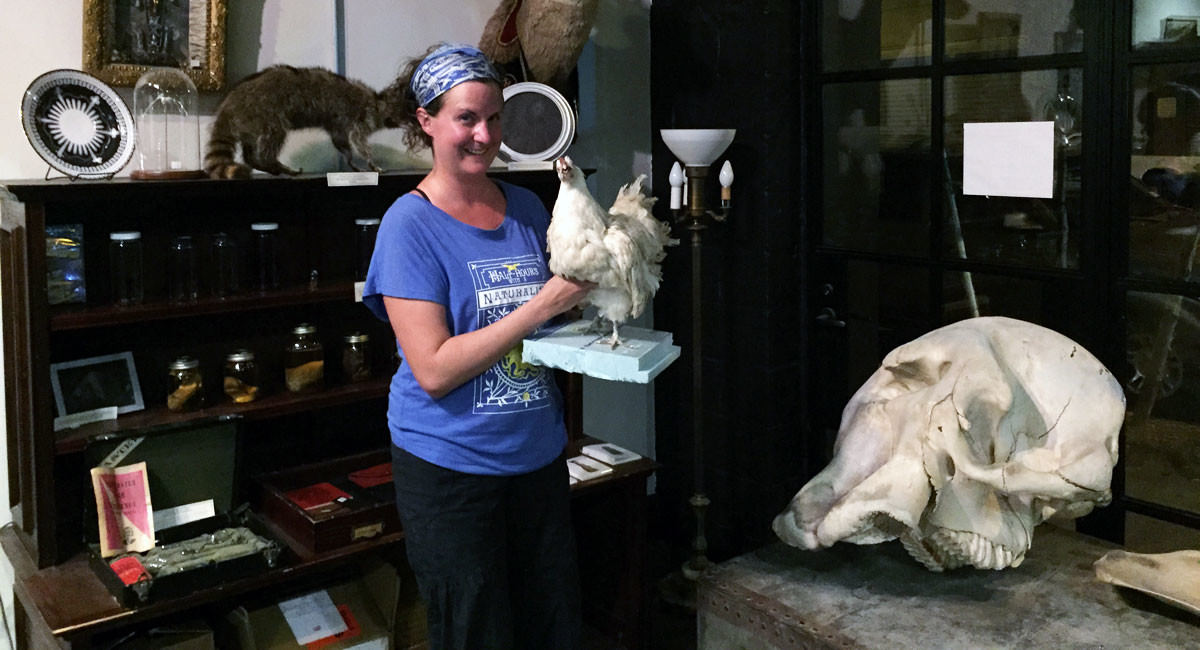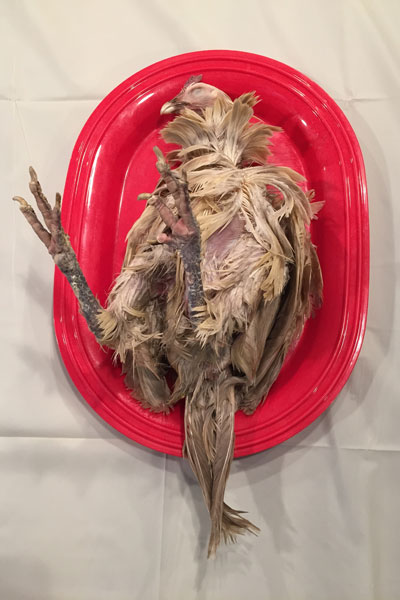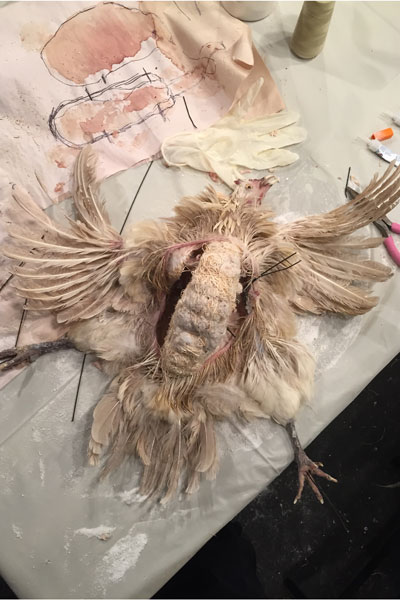The Art of Taxidermy: What It’s Like to Immortalize a Chicken
At Brooklyn’s Morbid Anatomy Museum hands-on taxidermy classes fill up with students for whom challenging themselves to skin and pose a deceased animal sounds like fun.
The Art of Taxidermy: What It’s Like to Immortalize a Chicken
At Brooklyn’s Morbid Anatomy Museum hands-on taxidermy classes fill up with students for whom challenging themselves to skin and pose a deceased animal sounds like fun.

Museum founder Joanna Ebenstein has turned her passion for the grotesque into a 4,200-square-foot space filled with a collection of oddities, plus coffee and curio shops, and an educational space for the macabre in the Gowanus neighborhood, next to the new Whole Foods and adjacent to the superfund river for which the area is named. As a former Brooklynite, I “liked” the museum’s page on Facebook – they’re prolific in their posting – but most of their updates went by my events stream unattended, while I found myself wistful for the days I lived there.
Once we get to work, there’s nothing magical about the process at all. That was the most surprising thing.
However, if anything were to snap me out of my New Jersey domesticity – my current life is as a chicken farmer, mother, and chef – the Fancy Chicken Taxidermy class I saw advertised on the was it. Every bit of the description, including the “don’t bring your own dead specimens to class” rule, more than piqued my fearless pursuit of the odd and conventionally repulsive.
So on a sunny Sunday in September, I drove back to the fringe of my old neighborhood to, literally, stuff a chicken. Who else had this class on their must-do list? All women – five students and two instructors – descended into the moody basement of the museum. Professional taxidermy instructor (that’s a real job!) Katie Innamorato says this is the norm. “Ninety-five percent of the classes I teach are all women,” she says, owing, we all suppose, to the modern crafting culture and Etsy-fication of interesting objects. Katie tells us this, along with tales of her chest freezers filled with “critters,” the beetle colonies she keeps to clean carcasses, and her pet fox Banjo who will be the recipient of the meat from our birds, all of whom are laying unceremoniously on red plastic dinner plates on a square vinyl-lined table.

The birds themselves are whole, intact, and dead of natural causes. They have been frozen and are cold, wet, and far from the beautiful feathered object into which we are all hoping they will be transformed. I’m tempted to say “magically transformed” but once we get to work, there’s nothing magical about the process at all. That was the most surprising thing.
To taxidermy a chicken means to turn it inside out and remove all but the paper-thin skin and a few clean bones which will provide structure. The carcass is removed using a scalpel. The leg and wing bones are left intact and the head is pushed back through its own neck. The feathers all folded in on themselves, like a lady removing a long silk glove. I pull the scalp forward off the skull and stop where the facial skin meets the beak, peeling the eyelids forward of the eyes, which I then pop out and move to the red plastic plate, with a growing pile of meat, fat, tendons and other assorted tissue.
[mf_image_grid_item src=”https://modernfarmer.com/wp-content/uploads/2015/10/splittingbird.jpg” alt=”” title=””]The skin is split down a center line, through which we remove all of the carcass.[/mf_image_grid_item]
[mf_image_grid_item src=”https://modernfarmer.com/wp-content/uploads/2015/10/Invertedface.jpg” alt=”” title=””]When removing the skin from the carcass, we push the head through the neck and release the comb from the skull.[/mf_image_grid_item]
Next comes “fleshing,” the heart of successful taxidermy. Using a combination of copper and steel brushes, dental tools, and 20 Mule Team Borax, we toil for more than two hours removing all of the fat, muscle, fascia, and tissues that would otherwise decay and cause stench and attract maggots. Excerebration happens through a hole we’ve cut in the back of the skull. The brain, mixed with Borax, becomes a granular, magenta paste to ease the removal.
[mf_image_grid_item src=”https://modernfarmer.com/wp-content/uploads/2015/10/fleshing.jpg” alt=”” title=””]Fleshing the inside of the chicken skin with the help of wire brushes and Borax.[/mf_image_grid_item]
[mf_image_grid_item src=”https://modernfarmer.com/wp-content/uploads/2015/10/glasseyemodelling.jpg” alt=”” title=””]We place the glass eye in modeling clay so it sits behind the eyelid.[/mf_image_grid_item]
Defleshed, the pelt goes in for a wash in dish detergent, a second wash with a dollar store miracle cleanser called Totally Awesome (whose other indications include vomit and nicotine removal), then a soak in fabric softener. Next, a few minutes under a blow dryer and suddenly I have something remarkably chicken-like to wire and wrap around a form I’ve sculpted from wood wool and cotton thread. She smells delightful and looks like David Bowie’s wig in Labyrinth.
[mf_image_grid_item src=”https://modernfarmer.com/wp-content/uploads/2015/10/soaking.jpg” alt=”” title=””]A soak in fabric softener and a cleanser called Totally Awesome is the last wet step.[/mf_image_grid_item]
[mf_image_grid_item src=”https://modernfarmer.com/wp-content/uploads/2015/10/jareth.jpg” alt=”” title=””]After fleshing and soaking, she gets a blowout over the back of a chair.[/mf_image_grid_item]

Fleshing is instructor Divya Anantharaman’s favorite part of the taxidermy process, and there is a great satisfaction in the sounds of scraping flesh, a dental chisel against bone, like picking a really good scab. But six hours in, the moment I’ve been most excited about is here. I lay the pelt over my form and sew her up the same scalpel line I used to take her apart. I fill out her thighs with some wool, pin her tail just so, and position her mid haughty stride.
I got the eyes perfectly symmetrical so she really does look alive, but she’s far from perfect. Her balance is off and she’s looking up, as if spying a hawk, a more animated gesture than I hoped to achieve. But she’s a beautiful reminder that I touched death. In fact I stuffed it, mounted it, and brought it home my to adorn mantle.
For more information and to sign up for a workshop, visit MorbidAnatomyMuseum.org. Taxidermy workshops start at $180 depending on the animal, and include all materials, complementary visit to the museum, and your own souvenir to take home.
Follow us
This work is licensed under a Creative Commons Attribution-NoDerivatives 4.0 International License.
Want to republish a Modern Farmer story?
We are happy for Modern Farmer stories to be shared, and encourage you to republish our articles for your audience. When doing so, we ask that you follow these guidelines:
Please credit us and our writers
For the author byline, please use “Author Name, Modern Farmer.” At the top of our stories, if on the web, please include this text and link: “This story was originally published by Modern Farmer.”
Please make sure to include a link back to either our home page or the article URL.
At the bottom of the story, please include the following text:
“Modern Farmer is a nonprofit initiative dedicated to raising awareness and catalyzing action at the intersection of food, agriculture, and society. Read more at <link>Modern Farmer</link>.”
Use our widget
We’d like to be able to track our stories, so we ask that if you republish our content, you do so using our widget (located on the left hand side of the article). The HTML code has a built-in tracker that tells us the data and domain where the story was published, as well as view counts.
Check the image requirements
It’s your responsibility to confirm you're licensed to republish images in our articles. Some images, such as those from commercial providers, don't allow their images to be republished without permission or payment. Copyright terms are generally listed in the image caption and attribution. You are welcome to omit our images or substitute with your own. Charts and interactive graphics follow the same rules.
Don’t change too much. Or, ask us first.
Articles must be republished in their entirety. It’s okay to change references to time (“today” to “yesterday”) or location (“Iowa City, IA” to “here”). But please keep everything else the same.
If you feel strongly that a more material edit needs to be made, get in touch with us at [email protected]. We’re happy to discuss it with the original author, but we must have prior approval for changes before publication.
Special cases
Extracts. You may run the first few lines or paragraphs of the article and then say: “Read the full article at Modern Farmer” with a link back to the original article.
Quotes. You may quote authors provided you include a link back to the article URL.
Translations. These require writer approval. To inquire about translation of a Modern Farmer article, contact us at [email protected]
Signed consent / copyright release forms. These are not required, provided you are following these guidelines.
Print. Articles can be republished in print under these same rules, with the exception that you do not need to include the links.
Tag us
When sharing the story on social media, please tag us using the following: - Twitter (@ModFarm) - Facebook (@ModernFarmerMedia) - Instagram (@modfarm)
Use our content respectfully
Modern Farmer is a nonprofit and as such we share our content for free and in good faith in order to reach new audiences. Respectfully,
No selling ads against our stories. It’s okay to put our stories on pages with ads.
Don’t republish our material wholesale, or automatically; you need to select stories to be republished individually.
You have no rights to sell, license, syndicate, or otherwise represent yourself as the authorized owner of our material to any third parties. This means that you cannot actively publish or submit our work for syndication to third party platforms or apps like Apple News or Google News. We understand that publishers cannot fully control when certain third parties automatically summarize or crawl content from publishers’ own sites.
Keep in touch
We want to hear from you if you love Modern Farmer content, have a collaboration idea, or anything else to share. As a nonprofit outlet, we work in service of our community and are always open to comments, feedback, and ideas. Contact us at [email protected].by Emily Peterson, Modern Farmer
October 2, 2015
Modern Farmer Weekly
Solutions Hub
Innovations, ideas and inspiration. Actionable solutions for a resilient food system.
ExploreExplore other topics
Share With Us
We want to hear from Modern Farmer readers who have thoughtful commentary, actionable solutions, or helpful ideas to share.
SubmitNecessary cookies are absolutely essential for the website to function properly. This category only includes cookies that ensures basic functionalities and security features of the website. These cookies do not store any personal information.
Any cookies that may not be particularly necessary for the website to function and are used specifically to collect user personal data via analytics, ads, other embedded contents are termed as non-necessary cookies.
I love how easy this looks, as a chicken keeper i’ve mummified and kept pelts but didn’t realise it could be this simple to mount.. i would have loved more pics of the finished product , if we get back to the states…interrupted trip due to covid I am coming to Morbid Anatomy for sure. GB – New Zealand
Wire brushes won’t be too traumatic or rough on the fine skin? I’ll give it a try! Not sure what my plans are for making a form but i’m sure i’ll figure something out.